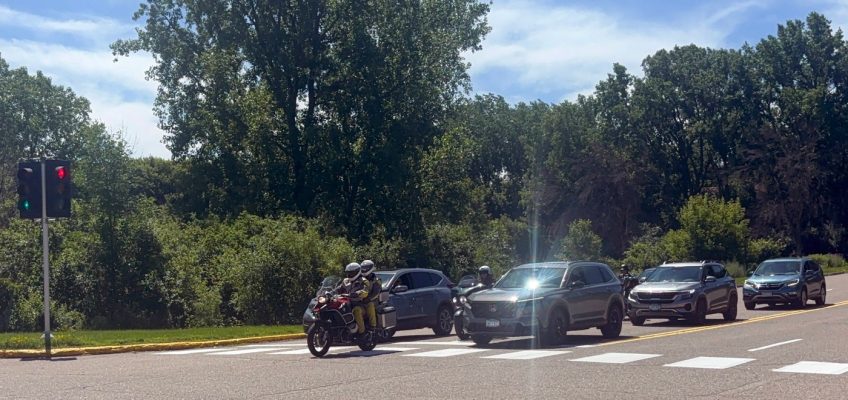The safety message of “Start Seeing Motorcycles” will take on more meaning in Minnesota on Tuesday as lane splitting and filtering for motorcyclists become legal.
Passed in the 2024 legislative session, the law takes effect on Tuesday.
“Our concern is for the safety and the lives of riders and drivers all across the state,” said Minnesota Office of Traffic Safety Director Mike Hanson on Monday. “Remember that safety is a shared responsibility. Everybody is going to have to practice and proceed with caution, awareness and patience.”
Here’s what to know about the new law, which Minnesota Motorcycle Safety Center’s Jay Bock calls “lane sharing” overall. It “allows motorcycles to share a lane with vehicles when it is appropriate, at the proper speed,” he said.
What is lane splitting, when does it apply?
Lane splitting allows a motorcycle to pass another vehicle in the same direction of travel and in the same traffic lane.
It’s permitted when two or more lanes of traffic are traveling in the same direction and traffic is moving.
Motorcyclists can lane split at no more than 15 mph over the speed of other traffic. For example, if traffic is crawling along at 5 mph, a motorcyclist’s maximum speed for lane splitting would be 20 mph.
Under all circumstances, the maximum speed for lane splitting is 25 mph.
What is lane filtering, when does it apply?
Lane filtering lets motorcyclists move through traffic that is stopped. It’s allowed when there are two or more lanes of traffic traveling in the same direction. It can be used in situations such as a traffic jam or drivers stopped at a traffic light.
At a demonstration on Monday, motorcyclists slowly pulled up between vehicles stopped at a red light at Minnesota’s Driver and Vehicle Services Eagan-South Metro Exam Station. They then advanced ahead of the vehicles when the light turned green.
Motorcyclists cannot travel more than 15 mph when using lane filtering.
When is lane splitting and filtering not allowed?
The new law does not apply to:
Round-abouts.
In a school zone.
In a work zone when only a single travel lane is available.
On an on-ramp to a freeway or expressway.
Why did this become law?
The American Motorcyclist Association supports lane splitting and filtering, and cites a University of California, Berkeley, analysis released in 2015. It “found that lane-splitting is relatively safe if done in traffic moving at 50 mph or less, and if motorcyclists do not exceed the speed of other vehicles by more than 15 mph.
Minnesota’s law says motorcyclists can’t travel more than 25 mph while lane filtering.
Minnesotan Phil Stalboerger advocated for the changes after he was rear-ended on his motorcycle while in traffic, which caused leg fractures to his wife, who was a passenger. He told legislators about the crash as a way to keep it from happening to other people.
“With this new ability to filter through slow-moving traffic and at stoplights, riders in Minnesota will benefit from increased safety on the open road,” American Motorcyclist Association Central States Representative Nick Sands said in a statement last year.
Did the Minnesota Department of Public Safety back this change?
DPS did not sponsor the legislation, Hanson said.
“This wasn’t an initiative that we brought forward,” he said. “Our position was we had some concerns with this. We all know our roads are busier and more congested than they’ve ever been, and we’re adding another element to that roadway congestion and all of the busyness going on around it. And so there were some concerns raised with how we could roll this out effectively and safely for everybody.”
The legislature appropriated $200,000 to the Office of Traffic Safety to educate people in the state over the last year.
Advice to motorcyclists and drivers?
Motorcyclists should keep in mind factors such as lane width, size of surrounding vehicles, weather, lighting conditions and whether they are visible to drivers.
“Riders, this is not a free pass for dangerous driving behaviors,” Hanson said. “Take it slow.”
Related Articles
Hoffman family releases statement about Hortman funeral
Gunman started Idaho blaze and then fatally shot 2 firefighters in ambush attack, officials say
Mikayla Raines, who rescued foxes and other animals, is dead at 30
Woodbury’s public safety campus is getting a $60 million renovation
Increased bear sightings in Forest Lake: What to know
Bock emphasized that while lane splitting and filtering is becoming legal, “they are not mandatory, and they’re not always the best option. Motorcyclists should use their best judgment about it and when they can do it safely.”
Upon reaching 25 miles an hour, motorcyclists are required to return to an assigned lane, Bock said.
“It is the responsibility of motorcyclists to practice these maneuvers safely,” he said. “Motorists … cannot impede, block or get in the way of a motorcyclist.”
Drivers should “respect that the riders have that right and to allow them the space to do that,” Hanson said. “… Never use your cell phone while driving or be distracted in any other way.”


Leave a Reply